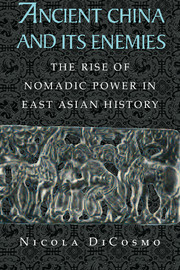Book contents
1 - The Steppe Highway: The Rise of Pastoral Nomadism as a Eurasian Phenomenon
Published online by Cambridge University Press: 25 August 2009
Summary
Geographic Features
A Note on Terminology
The terminology for the regions inhabited by the nomadic and seminomadic peoples of Inner Asia in pre-historical and historical times is inherently unstable, given that geographic areas such as Central Asia, Inner Asia, the Northern Zone, and Central Eurasia are usually defined ad hoc.
Because the present work is concerned mostly with what Owen Lattimore has called the “Inner Asian frontiers of China,” I have adopted “Inner Asia” or “Inner Asian frontier” as a general term for the eastern part of the continental mass of Eurasia. In practice, it includes three geographical areas: in the east, Manchuria; in the center, Mongolia, including parts of Kansu, northern Shensi, and northern Shansi; and in the west, not only today's Sinkiang but also the Minusinsk Basin and the northern part of the Altai Mountains.
This central definition must be accompanied by two others. The narrower term, the so-called Northern Zone, is used, especially in China, to describe the ecological and cultural frontier between China and Inner Asia. Today this area is entirely within China's political boundaries and runs from the Liao Valley in the east, to the T'ai-hang Mountains up to the Ordos region in the center, and to the Ning-hsia–Ch'ing-hai cultural region in the west. This term often refers to the area of the Great Wall, but to avoid anachronisms, “Northern Zone” is clearly preferable to “Great Wall Region.”
- Type
- Chapter
- Information
- Ancient China and its EnemiesThe Rise of Nomadic Power in East Asian History, pp. 13 - 43Publisher: Cambridge University PressPrint publication year: 2002
- 2
- Cited by

